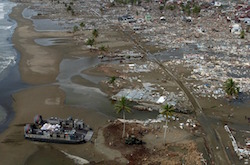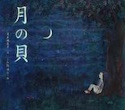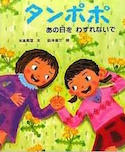by Yoo Kyung Sung, University of New Mexico, Albuquerque NM & Junko Sakoi, Tucson Unified School District, Tucson AZ
“March 11th, 2011, a 9.0 magnitude earthquake takes place in Tohoku area including Fukushima, Iwate and Miyagi, 231 miles northeast of Tokyo at a depth of 15.2 miles. The earthquake causes a tsunami with 30-foot waves that damage several nuclear reactors in Fukushima. It is the fourth-largest earthquake on record (since 1900) and the largest to hit Japan… The confirmed death toll is 15,893 as of October 9 2015” (CNN Library, 2015).
The Japan Tohoku earthquake resulted in global environmental concerns despite the fact that earthquake originally appeared to be a limited “Japanese” event. Tons of debris from the earthquake reached U.S. and Canadian shores in the following years (Mustain, 2011). Mustain (2011) describes the source of the debris: “Once the waters receded, they took scenes of the devastation with them. Piles of debris — smashed homes, cars, boats, and perhaps more grim reminders of the lives lost in the tsunami.”
The Tohoku earthquake and tsunami happened four years ago. Many survivors,though, still live with emotional and physical “debris” from the earthquake and subsequent tsunami. According to the record, on December 10, 2015, four years later, 186,602 people are still displaced (The Japan Metropolitan Police Department, 2015).
Children’s literature often becomes a societal mirror reflecting contemporaneous concerns of the time. Perhaps uniquely, children’s books also point to ways both young and adult readers could positively respond. Japanese disaster pictures show examples of such resiliency. In essence, children’s literature about the Japanese earthquake serves not only as a social mirror, but as a vehicle to evoke the importance of taking action to overcome the symbolic debris and build togetherness transcend sadness and trauma at the national level.
We have looked at 15 books about Tohoku and have framed different themes that may be helpful in raising awareness about various survivors’ situations following the earthquake. These books invite young readers to make empathetic connections with survivors who faced a range of challenges. The fact that there were so many survivors provides opportunities to explore a variety of thoughts and feelings that reflect the tremendous stresses they experienced.
Though the earthquake occurred four years ago, only fifteen picturebooks illustrating the experiences of the earthquake from a young child’s perspective have been published. If we added chapter books, the number of Tohoku earthquake books would be much bigger.
In looking at children’s literature about the disaster published between 2011 and 2015 in Japan, we noticed four emerging sub-themes: 1) young children’s perspectives in shelters, 2) spiritual empowerment from the lost to those who survived, 3) indirect support and empathy from readers in remote areas, and 4) natural disaster as a self-driven inquiry for children.
In these stories, young children encountered the direct or indirect impact of the disaster physically, emotionally and psychologically beginning with the earthquake and continuing indefinitely. Most of the stories are nonfiction. Just as September 11th has become a “I remembered where I was and what I was doing” date in the U . S., March 11th is now another milestone date to Japanese people.
The table below is a list of books linked to the pertinent theme. Junko translated the Japanese titles into English ones.
| Theme | Books |
| Young children’s perspectives in shelters
|
Well Water and My Dad (2012)
Dogwood Street (2013) Moon Shellfish (2013) Manhole Stage (2015) |
| Spiritual empowerment from the lost to the survived | Shake Hands (2013)
A Girl from Fukushima (2012) The Story of Ukedo Elementary School (2015) Invisible Bomb (2011) |
| Indirect supports and empathy from readers remote areas | I am from Fukushima (2013)
A Girl from Fukushima: Graduation (2015) Dandelion: Remember the Day (2011) Run Away from Tsunami (2013) |
| Natural disaster as children’s self-driven inquiry | Hana’s Fast Walking (2015)
Remember March 11 (2013) What is Running? (2015) |
Book lists with different themes of earthquake and disaster
Theme: Young Children’s Perspectives in Shelters
This theme focuses on the destruction of a child’s spatial normality after the earthquake. Sense of space is often strongly associated with a child’s agency and power. Staying in shelters demands a special kind of courage evident to young readers. This theme invites readers to think of what it feels like to be displaced and lose all sense of place and belonging. The details of the earthquake are portrayed in a time sensitive manner by revisiting the children’s regular schedules for that day leading to the moment when all normalcy is lost, warning young readers that anybody’s day could be disrupted by the unexpected. This is especially poignant for school children since the earthquake occurred on a Friday at 2:46 p.m. during school. A little boy at an elementary school in Remember March 11, 2011 (Shomei, 2012) and a little girl at a nursery school in Hana’s Fast Walking (Ube & Kanno, 2015) desperately fled the tsunami. They survived the disaster, losing a family member or pet, while enduring extended stays in a shelter. A boy in What is Running? (Wagou & Kimura, 2013) also must move to a shelter. There he and other young children struggled to overcome the traumatic event.
Theme: Spiritual Empowerment from the Lost to Those Who Survived
Perhaps this theme is a more culturally rooted one as it portrays being connected with the spirits of dead family members.Having an internal and external dialogue with family members who were killed during the earthquake may be a foreign concept to non-Japanese readers. However, those spiritual relationships kept empowering the survivors. Such relationships between the lost and the survived show a side of Japanese culture that provides a different way of coping with the loss. The social and personal meaning of death is evident in this theme. Three girls, Sachiko, in Well Water and My Dad (Chiba & Abe, 2012); Ena, in Moon Shellfish (Nagita & Komine, 2013); and Emily, in Manhole Stage (Terui, 2015), lose their father or mother in the tsunami. 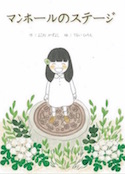 Sachiko and Ena’s deceased parents appear to them and assure them by saying “Don’t be so sad and don’t worry. I will be always with you.” Dogwood Street (Asanuma & Kuroi, 2013) is written from the perspective of a little boy who died in the tsunami. He finds out that his mother is grieving. He responds by whispering in her ears, “Don’t worry mom, I will be always with you.” Thus, in the stories, the survivor’s spiritual experiences comfort them at a deeply felt relational level and help them stay strong.
Sachiko and Ena’s deceased parents appear to them and assure them by saying “Don’t be so sad and don’t worry. I will be always with you.” Dogwood Street (Asanuma & Kuroi, 2013) is written from the perspective of a little boy who died in the tsunami. He finds out that his mother is grieving. He responds by whispering in her ears, “Don’t worry mom, I will be always with you.” Thus, in the stories, the survivor’s spiritual experiences comfort them at a deeply felt relational level and help them stay strong.
Theme: Indirect Support and Empathy from Readers in Remote Areas
Children suffer post-traumatic stress caused by displacement; loss of family members, friends or pets; and fear of invisible radiation contamination. With the support of families, new/old friends, pets, neighborhood and school communities and people around Japan, they transcend some of these emotionally crippling stresses. In A Girl from Fukushima: Graduation (Matsumoto & Matsumoto, 2015) and Dandelion: Remember the Day (Mitsuoka & Yamamoto, 2011), friendships are a significant factor to the girl protagonists in overcoming the shock of the disaster. Maya, in the story of A Girl from Fukushima: Graduation, comes back to her hometown, Fukushima, from Hiroshima three years after the disaster. She enjoys biking around the town and reuniting with her old friends unconcerned about radiation. 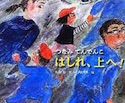 A boy in Run Away from Tsunami transfers to another school after the disaster. He feels safe when he receives a note to play, “Let’s play tag during lunch break!” from new friends. His and other schools celebrate the Star Festival together in summer of 2011, praying for the disaster victims.
A boy in Run Away from Tsunami transfers to another school after the disaster. He feels safe when he receives a note to play, “Let’s play tag during lunch break!” from new friends. His and other schools celebrate the Star Festival together in summer of 2011, praying for the disaster victims.
Theme: Natural Disaster as a Self-driven Inquiry for Children.
After the disaster, many children raised questions about nuclear plants and radiation leakage. These inquiries were not only from children in the damaged areas, but also from children who lived in safe locations far away from Tohoku. A range of books introduces facts and concepts that are pertinent to the earthquake and nuclear plants. In A Girl from Fukushima, for example, a boy living in Hiroshima, far away from Fukushima, meets a girl displaced from Fukushima. He learns about radiation risks as well as the earthquake resulted in her relocation. He had never heard the word “radiation” and started wondering what it was. His grandmother explains it to him. His dream now is to become the Prime Minister and resolve radiation problems and make people’s life safer and better. In Invisible Bomb, a character who is set twenty years in the future of Japan, experiences the fear and horror of an “invisible bomb’s” radiation. In this child’s world, radiation sickness from the radiation release is portrayed as a violation of childhood. The children in these stories live with the fear of radiation, but at the same time they gain agency to solve problems.
The bombing of Hiroshima is a globally known historical events. What is ironic is that Hiroshima became one of the areas for sheltering victims of the Tohoku earthquake. The town, nearly obliterated in WWII by the atomic bomb, now becomes a home to the Tohoku victims. This relays a meaningful and hopeful message that what was lost and damaged will eventually recover. However, it also stresses that people shouldn’t forget about Tohoku since it is still a very much ongoing event. Many victims continue to feel like the earthquake was just yesterday. While young readers need an understanding of the scientific concepts of earthquakes, they also need to develop critical literacy in reading about radiation effects and the physical and ideological social controls. What these picturebooks do is to serve as a tool for family, school, and community (both local and global) discussions.
The different themes and focuses of natural disaster in Japanese picturebooks show that children’s books ignite advocating voices among young readers for supporting and promoting awareness about the Tohoku victims. Japanese mass media hardly deals with this any more.
Next week, we will discuss community literacy outreach programs, which have a historical significance in Japan.
References
CNN Library. (2015). 2011 Japanese Earthquake-Tsunami Fast Facts. CNN. Retrieved from http://www.cnn.com/2013/07/17/world/asia/japan-earthquake—tsunami-fast-facts/
The Japan Metropolitan Police Department. (2015). Damage Statistics in 2015: Summary of the Tohoku Earthquake. Retrieved from
http://www.npa.go.jp/archive/keibi/biki/higaijokyo.pdf
Mustain, A. (2011) Japanese Tsunami Debris Expected on U.S. Shores in 3 Years. LiveScience. Retrieved from http://www.livescience.com/13680-japan-tsunami-earthquake-debris-united-states.html
Journey through Worlds of Words during our open reading hours: Monday-Friday, 9 a.m. to 5 p.m. and Saturday, 9 a.m. to 1 p.m. To view our complete offerings of WOW Currents, please visit archival stream.
- Themes: Japanese Children's Literature, Junko Sakoi, Yoo Kyung Sung
- Descriptors: Books & Resources, Student Connections, WOW Currents

